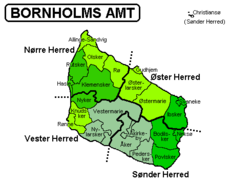- Bornholm disease
-
Bornholm disease Classification and external resources 
BornholmICD-10 B33.0 ICD-9 074.1 DiseasesDB 29152 eMedicine med/464 MeSH D011000 Bornholm disease or epidemic pleurodynia or epidemic myalgia[1] is a disease caused by the Coxsackie B virus or other viruses.[2]
It is named after the Danish island Bornholm where early cases occurred.
Contents
Signs and symptoms
Symptoms may include fever and headache, but the distinguishing characteristic of this disease is attacks of severe pain in the lower chest, often on one side.[3] The slightest movement of the rib cage causes a sharp increase of pain, which makes it very difficult to breathe, and an attack is therefore quite a frightening experience, although it generally passes off before any actual harm occurs. The attacks are unpredictable and strike "out of the blue" with a feeling like an iron grip around the rib cage. The colloquial names for the disease, such as 'The Devil's grip' (see also "other names" below) reflect this symptom.
Cause
Inoculation of throat washings taken from people with pleurodynia into the brains of newborn mice revealed that enteroviruses in the Coxsackie B virus group were likely to be the cause of pleurodynia,[4] and those findings were supported by subsequent studies of IgM antibody responses measured in serum from people with pleurodynia.[5] Other viruses in the enterovirus family, including echovirus and Coxsackie A virus, are infrequently associated with pleurodynia.[6]
Epidemiology
Coxsackie B virus is spread by contact and epidemics usually occur during warm weather in temperate regions and at any time in the tropics. As is typical with this virus family, it is shed in large amounts in the feces of infected persons.[7] The disease can be spread by sharing drink containers,[8] and has been contracted by laboratory personnel working with the virus.[4]
Treatment and prognosis
The illness lasts about a week and is rarely fatal. Treatment includes the administration of nonsteroidal anti-inflammatory agents or the application of heat to the affected muscles. Relapses during the weeks following the initial episode are a characteristic feature of this disease.[9]
History
In 1872, Daae-Finsen reported an epidemic of "acute muscular rheumatism" occurring in a community called Bamble, giving rise to the name "Bamble disease" in Norway. Subsequent reports, published only in Norwegian, referred to the disease by this name. In 1933, Ejnar Sylvest gave a doctoral thesis describing a Danish outbreak of this disease on Bornholm Island entitled, "Bornholm disease-myalgia epidemica", and this name has persisted.[9]
Other names
It is also known as Bamble disease,[9] the devil's grip, devil's grippe, epidemic myalgia, epidemic pleurodynia, epidemic transient diaphragmatic spasm or The Grasp of the Phantom.
References
- ^ HOPKINS JH (May 1950). "Bornholm disease". Br Med J 1 (4664): 1230–2. doi:10.1136/bmj.1.4664.1230. PMC 2038054. PMID 15420445. http://www.pubmedcentral.nih.gov/articlerender.fcgi?tool=pmcentrez&artid=2038054.
- ^ "epidemic pleurodynia" at Dorland's Medical Dictionary
- ^ WARIN JF, DAVIES JB, SANDERS FK, VIZOSO AD (June 1953). "Oxford epidemic of Bornholm disease, 1951". Br Med J 1 (4824): 1345–51. doi:10.1136/bmj.1.4824.1345. PMC 2016648. PMID 13042253. http://www.pubmedcentral.nih.gov/articlerender.fcgi?tool=pmcentrez&artid=2016648.
- ^ a b WELLER TH, ENDERS JF, BUCKINGHAM M, FINN JJ (September 1950). "The etiology of epidemic pleurodynia: a study of two viruses isolated from a typical outbreak". J. Immunol. 65 (3): 337–46. PMID 14774516. http://www.jimmunol.org/cgi/pmidlookup?view=long&pmid=14774516.
- ^ Schmidt NJ, Magoffin RL, Lennette EH (September 1973). "Association of group B coxsackie viruses with cases of pericarditis, myocarditis, or pleurodynia by demonstration of immunoglobulin M antibody". Infect. Immun. 8 (3): 341–8. PMC 422854. PMID 4199715. http://iai.asm.org/cgi/pmidlookup?view=long&pmid=4199715.
- ^ Bell EJ, Grist NR (July 1971). "ECHO viruses, carditis, and acute pleurodynia". Am. Heart J. 82 (1): 133–5. doi:10.1016/0002-8703(71)90173-6. PMID 5581711.
- ^ Chong AY, Lee LH, Wong HB (June 1975). "Epidemic pleurodynia (Bornholm disease) outbreak in Singapore. A clinical and virological study". Trop Geogr Med 27 (2): 151–9. PMID 1179480.
- ^ Ikeda RM, Kondracki SF, Drabkin PD, Birkhead GS, Morse DL (November 1993). "Pleurodynia among football players at a high school. An outbreak associated with coxsackievirus B1". JAMA 270 (18): 2205–6. doi:10.1001/jama.270.18.2205. PMID 8411604.
- ^ a b c Vogelsang TM (January 1967). "The occurrence of Bamble Disease (epidemic pleurodynia) in Norway". Med Hist 11 (1): 86–90. PMC 1033670. PMID 5341038. http://www.pubmedcentral.nih.gov/articlerender.fcgi?tool=pmcentrez&artid=1033670.
Infectious diseases · Viral systemic diseases (A80–B34, 042–079) Oncovirus Immune disorders Central
nervous systemEncephalitis/
meningitisDNA virus: JCV (Progressive multifocal leukoencephalopathy)
RNA virus: MeV (Subacute sclerosing panencephalitis) · LCV (Lymphocytic choriomeningitis) · Arbovirus encephalitis · Orthomyxoviridae (probable) (Encephalitis lethargica) · RV (Rabies) · Chandipura virus · Herpesviral meningitis · Ramsay Hunt syndrome type IIEyeCardiovascular Respiratory system/
acute viral nasopharyngitis/
viral pneumoniaDigestive system Urogenital 
This infectious disease article is a stub. You can help Wikipedia by expanding it.
